Bivouac for Climbing: The Ultimate Guide (2024)

Published on: 07/27/2023
High in the mountains with limited daylight? Time to bivy up.
If you have been climbing long enough, you probably have a story or two about “that one time” — an experience where delays forced your team to spend an unplanned night on the wall or mountain. Depending on a variety of factors (location, available equipment, weather, etc.) this improvised camp, or “bivouac,” may have been pleasant and restful. Or it may have been a miserable test of mental endurance in the cold.
The probability of needing to bivouac increases as you venture further into the mountains. For this reason, all experienced climbers include some form of overnight kit in their climbing gear.

What is a Bivouac?
A bivouac, or “bivy” for short, is any overnight shelter used while on a climbing route. Most climbing parties must regain body heat and strength after a long day of physical exertion. Therefore, they search for a suitable bivy spot once dusk approaches.
The term “bivouac” traces back to the French military. Derived from the Swiss-German term “bi-wacht,” it roughly translates to “night watch” (1). Hikers and climbers gradually adopted it to describe camping situations without the normal comforts of a family camping trip.
Although buying a bivy sack (a mummy-shaped waterproof bag to put over your sleeping bag) is possible, most climbers use the term as a disambiguation to refer to various overnight sleeping scenarios.
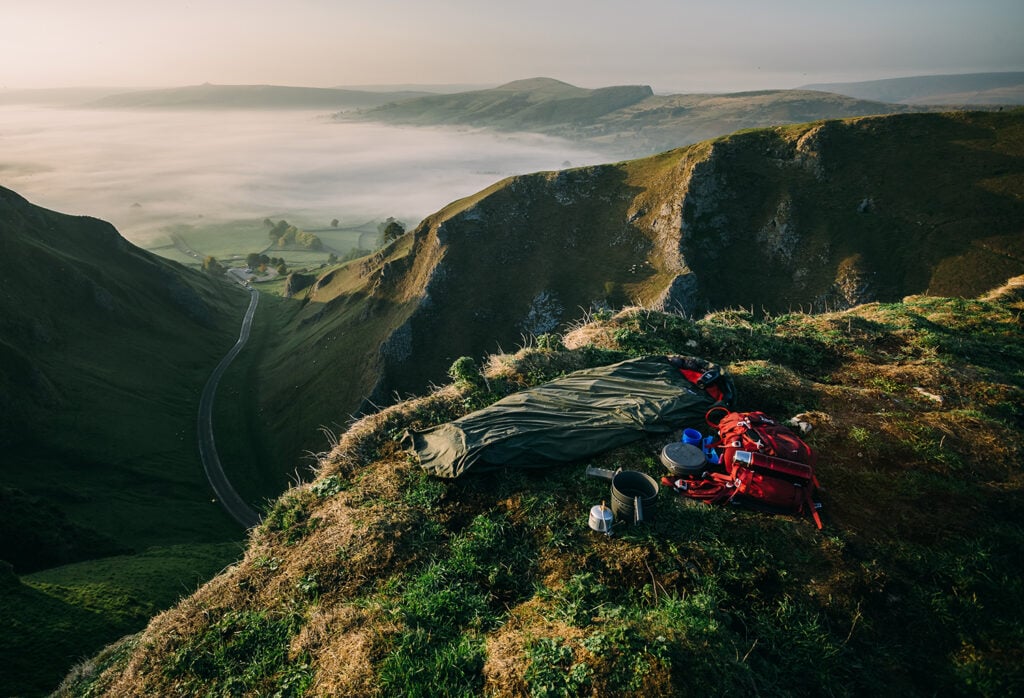
How Do Climbers Bivy?
The best type of bivy for any given trip will be dictated by the terrain, weather, and planned trip length. For a summer bivy in good weather, you might be perfectly comfortable laying out the rope as an improvised sleeping pad on a sheltered ledge and using a puffy belay parka to keep out the cold.
During harsh winter conditions and in the snow, there’s no real substitute for a four-season single-wall tent, down sleeping bags, and an insulated sleeping pad for every member of the party.

Between these two extremes there are many more combinations of gear that can be used to safely and effectively get some rest while on route. Below are the most common pieces of gear used to bivy, and how to use them right.
Bivouac Sack A.K.A. Bivy Bag
The bivouac sack is a sleeping bag-sized bag made from either waterproof or water resistant fabric. Most people prefer not using bivy bags on a regular basis. Indeed, they tend to have problems with condensation and also feel somewhat claustrophobic. If you are unfortunate enough to get caught in direct rain while in a bivy sack, you will need to seal off the top completely to avoid water splashing your face.
The bivy bag does have some benefits though:
- It’s lightweight;
- Packs down small;
- And it can be deployed in small spaces.
In warm weather, a bivy bag and a puffy jacket can be used together to keep out the wind and retain a bubble of warm air around the body. In colder temperatures in can be used with a sleeping bag and pad for better warmth.
For those planning on bivouacking on small exposed ledges, Black Diamond sells a vertical camping version of the bivy bag with a full-strength tie-in point for big wall climbing. For larger groups seeking an ultralight, emergency-style setup, Rab makes a range of 2–10 person “bothy bags.”
Sleeping Bag
Sleeping bags are a great way to add warmth to any bivy. In dry summer conditions without much wind, a sleeping bag alone is enough to keep a climber warm and give them a good night’s sleep. When bad weather moves in, a sleeping bag can be combined with a bivy, tent, or tarp to stay dry and protected.
In general, the best type of bag to bring along for a climbing bivouac is one that’s lightweight and packs small.
A sleeping bag can always be used in tandem with a puffy jacket and any other insulation layers like fleece, long underwear, and even removable boot liners. It’s also possible to find 1/2 length sleeping bags that are designed to keep your legs warm while a puffy jacket retains torso warmth. Similarly, bottomless quilt-style bags are increasingly popular for their low weight and pack size.
The most important thing to keep in mind when using a sleeping bag is the need to keep it dry.

Tent
Tents are by far the most reliable and comfortable option for camping high in the mountains. However, their superior protection comes with a significant weight penalty. Despite this, tents are pretty much mandatory while alpine climbing and whenever heading into terrain that is unknown where cold weather could be a real problem. To cut down on excess weight, most climbers choose a single wall, 4-season tent.
The benefits of a tent are enticing. Entering a small bubble of warmth can definitely take the edge off during stressful situations. It’s also crucial for safety if you get stuck exposed in a big storm.
Consider that you may also need to climb with or haul the tent, find an appropriate spot to set it up, and also potentially dig out snow for this shelter to work. If it’s possible, a very popular and safe method is setting your tent up and sleeping at the base of your climb, leaving it up during the day and then returning to it as night approaches. Just make sure you start making appropriate decisions as dusk approaches, and understand when you may need to start the rappel back to shelter!
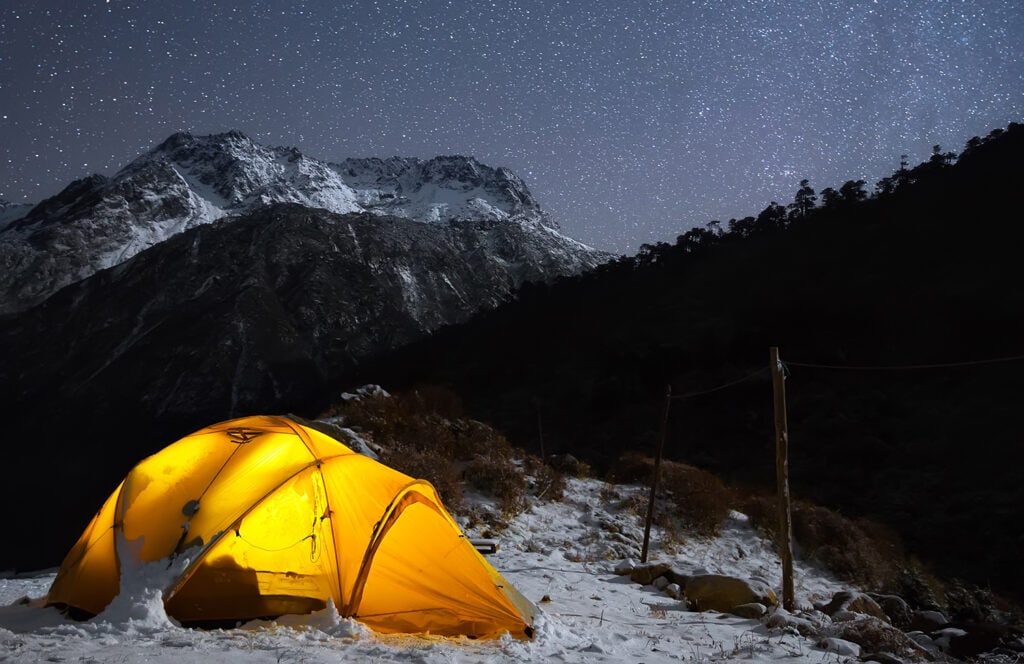
Sleeping Pad
When resting laying down, it’s important to find a way to insulate yourself from the ground. If you fail to adequately insulate yourself on the bottom, you will lose a lot of heat from this point of contact. Even a great sleeping bag will not keep you from getting cold.
It’s possible to improvise ground insulation using your rope. However, it won’t provide a great deal of warmth. Ropes can also occasionally get wet (especially in icy and snowy conditions), making them unsuitable for this purpose.
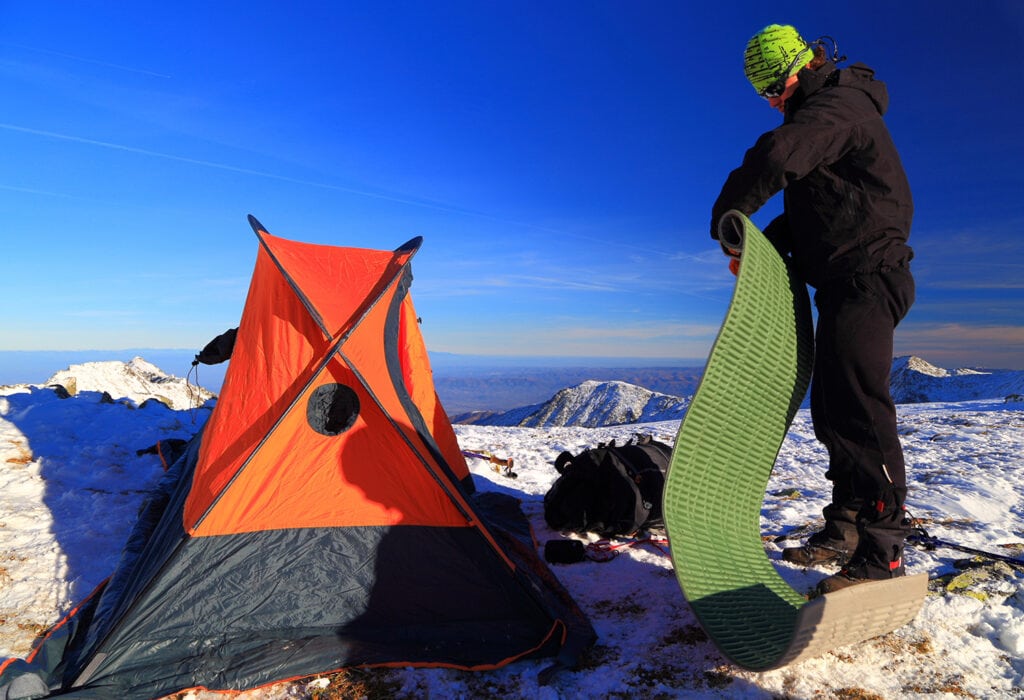
There are two main types of sleeping pads on the market: closed cell foam and inflatable. Each has both positive and negative aspects.
Closed cell foam pads
These sleeping pads have been around the longest and are recognizable to most who have camping experience. They are made of a large piece of foam that is either folded or rolled up during transport.
Closed cell foam pads are extremely durable. Therefore, there’s no need to worry about puncturing them or needing to repair them. The downside is that they are bulky and don’t provide a very impressive amount of insulation.
Inflatable pads
These come in many styles, some with foam or reflective film on the inside to provide better insulation. The upsides of inflatable pads are weight, pack size, and superior insulation.
However, inflatable sleeping pads are known to fail if punctured or if a seam rips open, leaving you with nothing.
Lastly, it’s important to note that any ground insulation you gain from a pad is stackable. You can lay an inflatable pad on top of a rope and combine the R values of the two (or any other combination of pads).
Portaledge
If you’re planning a big wall climb, chances are you will need a portaledge for the night. A portaledge is a portable platform, similar to a tent, with a metal frame and fabric cover that climbers secure to anchors on big walls.
It’s literally vertical camping: the portaledge hangs in the air, which can feel a bit scary. However, it’s quite safe as each climber wears their harness and is secured independently to an anchor on the wall.
For more information, you can check out this dedicated article on the topic: How Rock Climbers Sleep: An Intro to Portaledges.
Other Considerations and Tips

As you’ve seen, it’s important to design every trip with either a planned bivy in mind or an emergency bivouac available. Here are a few more important items you should always take:
- An emergency blanket takes up almost no room in your pack, yet it will help you survive if you are stranded on route throughout the night.
- If you are in an alpine environment also consider bringing a stove for melting snow and getting water. Remember that unless there will be natural fuel to burn during an emergency on route, you need to bring your own. A fire starter or lighter will not help very much unless you find something to burn. And even then, you will be violating the principles of leave no trace. Therefore, we always recommend to have a camp stove.
- Always carry a headlamp or other light for night vision.
- Carrying a first-aid kit is mandatory for any outdoor activity, not just bivouacking, but it’s easy to forget.
Nutrition
Last but not least, remember that while resting your body temperature will be dependent on the food you are putting into your system. It’s wise to always carry an extra emergency freeze dried meal in your pack.
Lack of food can not only worsen symptoms of the cold. Also, it will reduce your energy the day after you bivy and can lead to muscle cramps, headaches, and less precise body control.
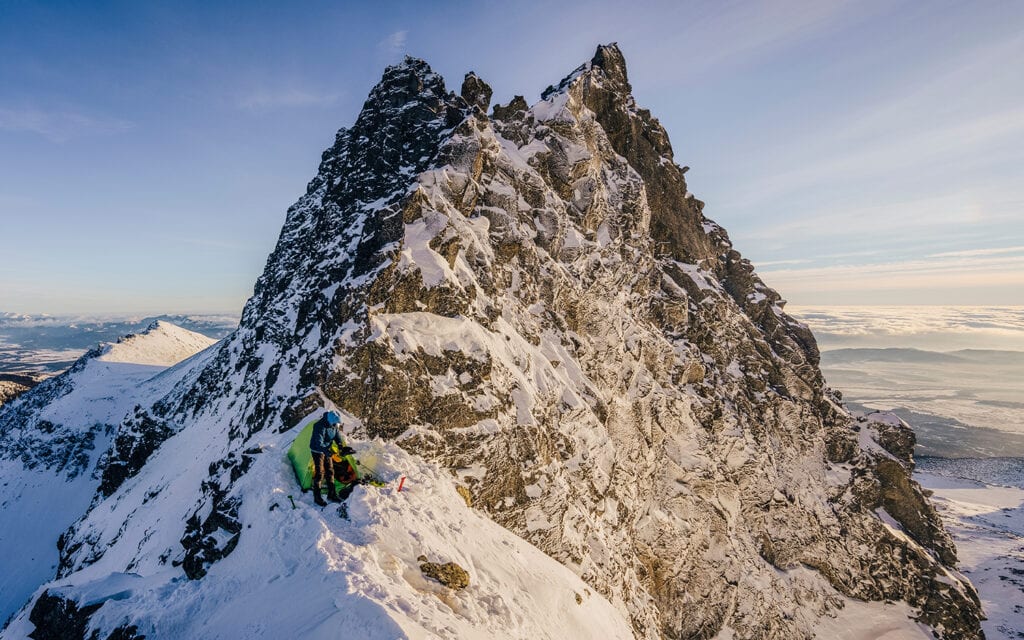
Cool hacks
There are many hacks that have been used by climbers over the years to make a bivy more comfortable (or to simply survive it):
- Many backpacks have a foam insert that can be used as a sleeping pad.
- Nalgene bottles and dromedary bags can be filled with boiling water and used to provide extra warmth for a few hours at a time.
- Snow and talus can be moved to create a bit of shelter.
If you plan well you won’t need to resort to these methods (hopefully), but they are good to know in case of emergency.
Frequently Asked Questions
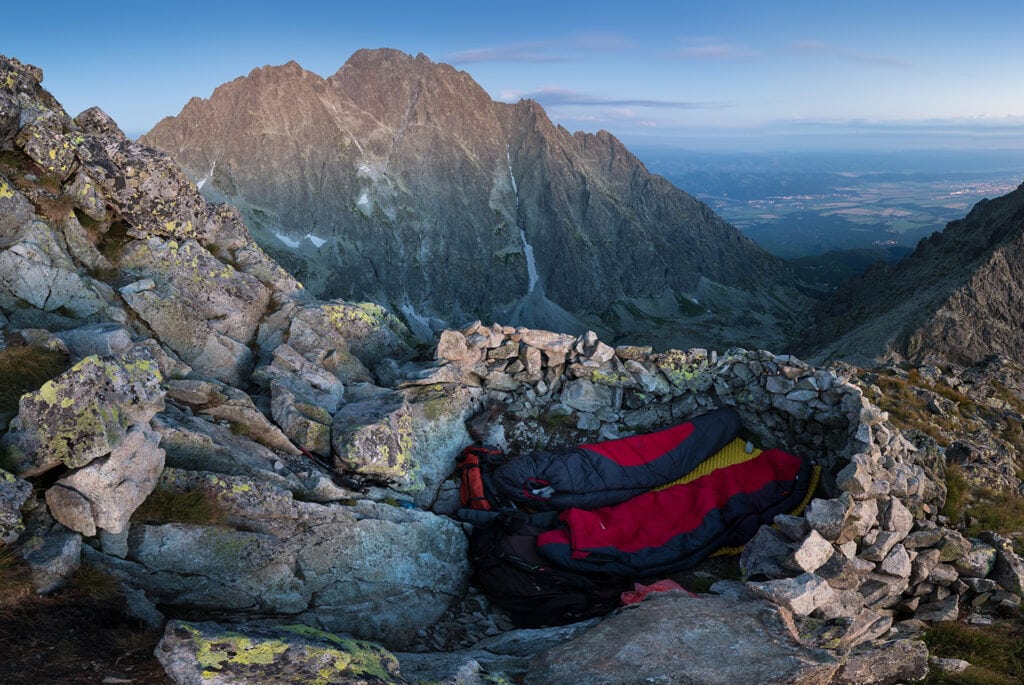
A bivy is any type of overnight setup for sleeping while climbing. It could be on a ledge, in dug out snow, or at the base of a climb.
The term “bivouac” comes from the French military, meaning “night watch.”
There’s no difference between the two. “Bivy” is just a shortened version of bivouac.
There are many ways to bivy on a mountain. Climbers accomplish this by using tents, sleeping bags, bivy bags, tarps, and, if on a cliff, portaledges.
If someone says they completed a climb in “bivouac style” it means that they spent the night on the route and probably brought a minimal amount of camping equipment.
References
Bivouac (in French)
Dictionnaire de l’Académie française
https://www.dictionnaire-academie.fr/article/A9B1284

